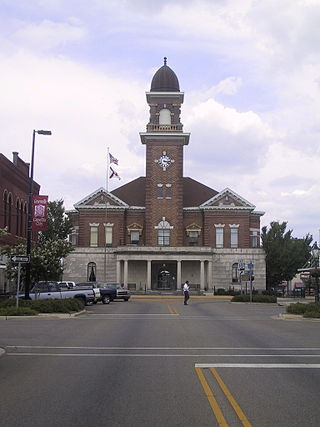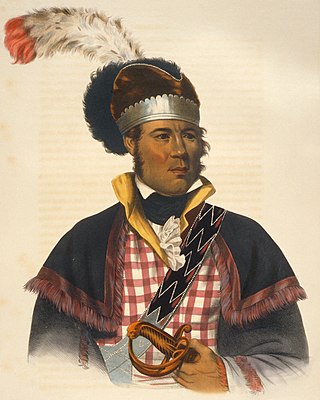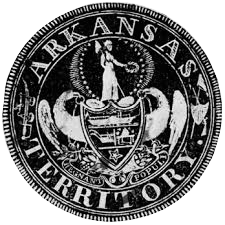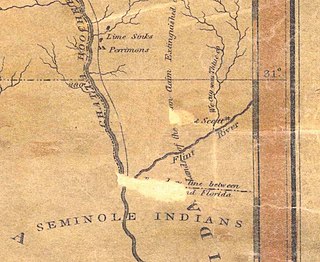Related Research Articles

Butler County is a county located in the south central portion of the U.S. state of Alabama. As of the 2020 census, the population was 19,051. Its county seat is Greenville. Its name is in honor of Captain William Butler, who was born in Virginia and fought in the Creek War, and who was killed in May 1818.

David Holmes was an American politician in Virginia and Mississippi. He served five terms as a U.S. congressman from Virginia's 2nd congressional district and later was important in Mississippi's development as a state. The federal government appointed him as the fourth and last governor of the Mississippi Territory. In 1817 he was unanimously elected as the first governor of the state of Mississippi. He served a term as U.S. senator from Mississippi, appointed to fill a vacancy until elected by the legislature. Elected again as governor, he was forced to resign early due to ill health. He returned to Virginia in his last years.

The Creek War, was a regional conflict between opposing Native American factions, European powers, and the United States during the early 19th century. The Creek War began as a conflict within the tribes of the Muscogee, but the United States quickly became involved. British traders and Spanish colonial officials in Florida supplied the Red Sticks with weapons and equipment due to their shared interest in preventing the expansion of the United States into regions under their control.

The Territory of Mississippi was an organized incorporated territory of the United States that was created under an organic act signed into law by President John Adams on April 7, 1798, and was dissolved on December 10, 1817, when the western half of the territory was admitted to the Union as the State of Mississippi. The eastern half was redesignated as the Alabama Territory until it was admitted to the Union as the State of Alabama on December 14, 1819. The Chattahoochee River played a significant role in the definition of the territory's borders. The population rose in the early 1800s from settlement, with cotton being an important cash crop.

John Williams was an American lawyer, soldier, and statesman, operating primarily out of Knoxville, Tennessee, in the first part of the 19th century. He represented Tennessee in the United States Senate from 1815 to 1823, when he lost reelection to Andrew Jackson. Williams also served as colonel of the 39th U.S. Infantry Regiment during the Creek Wars, and played a key role in Jackson's victory at the Battle of Horseshoe Bend in 1814.

William McIntosh, was also commonly known as Tustunnuggee Hutke, was one of the most prominent chiefs of the Creek Nation between the turn of the nineteenth century and his execution in 1825. He was a chief of Coweta town and commander of a mounted police force. He became a large-scale planter, built and managed a successful inn, and operated a commercial ferry business. Early American historians attributed McIntosh's achievements and influence to his mixed race Scots/European ancestry. Since the late 20th century, historians have argued much of McIntosh's political influence stemmed more from his Creek upbringing and cultural standing, particularly his mother's prominent Wind Clan in the Creek matrilineal system, and to other aspects of Creek culture.

David Brydie Mitchell was a Scottish born American politician in Georgia who was elected in 1809 as governor of the state, serving two terms. He was elected again in 1815 for one term.
Thomas Butler was an American politician and lawyer who served in the United States House of Representatives from 1818 to 1821, representing the at-large congressional district of Louisiana as a member of the Democratic-Republican Party.
Tunstall Quarles was a United States lawyer and politician, as well as one of the pioneer settlers of Somerset, Kentucky in Pulaski County.
Jabez Leftwich was an American politician, planter and military officer who represented Virginia's 14th congressional district in the U.S. House of Representatives between 1821 and 1825, as well as served in the Virginia House of Delegates representing Bedford County, and finally represented Madison County, Alabama in the Alabama House of Representatives after moving to that new state.
William Butler was an American militiaman who fought in the Creek War. Born in Louisa County, Virginia, he moved to Hancock County, Georgia, where he married Charity Garrett in 1796 and served in the state legislature. He then moved west to the Alabama Territory. He served as a militia leader during the Creek War of 1813–1814.

Fort Crawford was a fort that once provided defense for settlers in what is today East Brewton, Alabama.

The Militia of the Territory of Arkansas, commonly known as the Arkansas Militia, was the forerunner of today's Arkansas National Guard. The current Arkansas Army National Guard traces its roots to the creation of the territorial militia of the District of Louisiana in 1804. As the District of Louisiana evolved into the Territory of Missouri and the first counties were organized, regiments of the Missouri territorial militia were formed in present-day Arkansas. Territorial governors struggled to form a reliable militia system in the sparsely populated territory. When the Arkansas Territory was formed from the Missouri Territory, the militia was reorganized, gradually evolving from a single brigade composed of nine regiments to an entire division composed of six brigades, each containing four to six regiments. The local militia organization, with its regular musters and hierarchy added structure to the otherwise loosely organized territorial society. The Territorial Militia was utilized to quell problems with the Indian Nations and was held in readiness to deal with trouble along the border with Mexico due to an ambiguous international border and during the prelude to the Texas War of Independence.

Slavery played the central role during the American Civil War. The primary catalyst for secession was slavery, especially Southern political leaders' resistance to attempts by Northern antislavery political forces to block the expansion of slavery into the western territories. Slave life went through great changes, as the South saw Union Armies take control of broad areas of land. During and before the war, enslaved people played an active role in their own emancipation, and thousands of enslaved people escaped from bondage during the war.
Charles Rinaldo Floyd was an American planter, politician and military leader most famous for his leading the Trail of Tears out of Georgia and for his Okefenokee Campaign during the Second Seminole War. He wrote one of the first published accounts of the Okefenokee Swamp. His diary portrays elite planter life on the Georgia frontier.
John Dabney Terrell Sr., surveyor, planter, and politician in Alabama, was born to a planter family in Bedford County, Virginia, and died in Marion County, Alabama. He moved to the region about 1814, well before Indian Removal which began in the 1830s, and served as the United States Indian Agent to the Chickasaw under two presidents. He developed a plantation and was a slaveholder. He became active in territorial and state politics, serving as a state senator and also as a state representative.

John Thompson Drew was a mixed blood military and political leader of the Cherokee Nation. Born in 1796, there is little written about his life until he led a company of Cherokee emigrants from Georgia to Indian Territory. The Cherokee Encyclopedia states that he was a participant in the Battle of Claremore Mound in 1818. He is best known for joining the Confederate Army at the outbreak of the American Civil War, when he raised, organized and led the 1st Cherokee Mounted Rifles. He moved his home from the Cherokee Nation to the Chickasaw Nation near the end of the war to escape intra-tribal bloodshed.
Joel Leftwich was an American planter and politician, who also served as brigadier general of the Virginia militia in the War of 1812 and twice represented Bedford County in the Virginia House of Delegates.

Fort Scott was built in 1816 on the west bank of the Flint River, where it joins the Chattahoochee River to form the Apalachicola, in the southwest corner of Georgia. It was named for Lieutenant Richard W. Scott, who was killed in the Scott Massacre of 1817 and never known to have visited the fort. The need for a fort became evident during the War of 1812, when the British identified the undefended United States border and in 1814 built two forts on the Apalachicola River into which the Flint River flows: a strong fort at Prospect Bluff and a smaller one, Nicolls' Outpost, at the river juncture. This was in Spanish Florida, but Spain had neither the resources nor the inclination to do anything about the fort in a location that was remote.
Fort Montgomery was a stockade fort built in August 1814 in present-day Baldwin County, Alabama, during the Creek War, which was part of the larger War of 1812. The fort was built by the United States military in response to attacks by Creek warriors on encroaching American settlers and in preparation for further military action in the War of 1812. Fort Montgomery continued to be used for military purposes but in less than a decade was abandoned. Nothing exists at the site today.